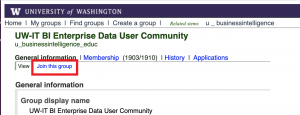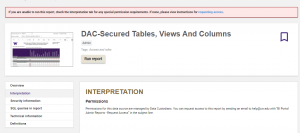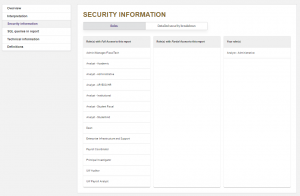This page helps users resolve the most common questions about working with reports, dashboards, and cubes available in the BI Portal or UW Profiles. If your question isn’t answered here, please write help@uw.edu.
Access
Not sure if you have access to Enterprise Data Warehouse (EDW) data and tools? Or want to find out what kind of access you have? Any UW employee can use ASTRA to view their EDW access.
- Navigate to ASTRA
- Click on “Show Me My Authorizations“.
- Login using your UW NetID and password
- ASTRA will display a list of authorizations:
- Look under the Application column – you have access to EDW data, reports, cubes, and dashboards if you see EDW listed. The data you can access is governed by the role to which you have been assigned. In the example above, the user has been assigned to the EDW Administrator role. Note: you may have been granted access to more than one role.
- If you need to request new or different access to EDW, visit the Request Permission and Access Data page.
In addition to ASTRA steps described above, there are other ways to explore your access, which are outlined on this page in our wiki: Manage Access.
Note: You must be logged into Husky OnNet (VPN) in order to access this video. For more information, refer to Husky OnNet.
For more information on EDW security, visit the Data Security page.
Resources and Training
Enterprise Reporting and Analytics hosts monthly webinars on Zoom to help users understand the data products we support. These webinars are free and open to the Enterprise Data User Community.
Attend the Webinar to:
- Learn about data and reporting tools available on the BI Portal.
- Learn about Academics, Finance, or Research topics.
- See demonstrations of how users like you use data tools at the UW.
The links below allow you to join one or more of the UW Groups we have set up. These groups are based on subject area. If you’re interested in finance topics, then join the Finance Group. If you’re interested in research, then join the Research Group. Join both groups if you’re interested in both finance and research. Once you sign up for a group, you’ll receive webinar invitations on that topic and will always know when webinars relevant to your work are happening.
To join a group, click on “Join this group”
You can view all of our upcoming events in the Enterprise Reporting and Analytics (ERA) Trumba calendar.
Our office does not currently have any resources dedicated to hosting in-person trainings. If you would like more training on Excel or other data tools, we recommend you explore the following:
Enterprise Data Warehouse (EDW)
There are a number of different ways to connect to the EDW. Click the following links to learn more:
Reports
You must set up a Virtual Private Network (VPN) to access reports, cubes, dashboards or Enterprise Data Warehouse data from off campus. UW provides this secure remote connection through Husky OnNet. This service is provided at no additional cost to UW students, faculty and staff as part of the Basic Bundle of services covered under the Technology Recharge Fee. To access the service, go to the Husky OnNet UWare page.
Some of the most common issues users report regarding report-running are:
Logging In
To access cubes or reports, you will need to access the UW NetId domain using your UW NetID username and password.
See the Logging In frequently asked question
Data Unavailable
When running a report, you may encounter an error message that resembles the image below.

Cryptic? Yes. Helpful? Not really. But the bottom line is that a database needed by the report isn’t available and one of two things is happening:
- The database is being loaded with data
- The database is unavailable due to maintenance or an unexpected outage
You can check for both situations using the Data Availability Summary, as described below.
What does “Database is Loading” mean?
The Last Loaded Column usually shows the the date and time that the database is loaded. If the database is loading (usually at night or early morning) , you’ll see the “Loading…” message in the Last Loaded column of the Data Availability Summary.
Is Data Current?
The Load Frequency is the scheduled frequency of the database being uploaded, therefore (Excluding Legacy HEPPS Databases) if the frequency is daily, the Last Loaded date should never be , greater than two days old. For the the Legacy HEPPS, data loads were frozen post Workday release in 2017. No database is loaded more than once a day.
How can I tell if I have access to a Report?
When attempting to run a report if you see a pink caption as shown in the image below, it indicates that the report is not accessible to the user’s Astra Role. Go to the Interpretation Tab to check permissions and instructions on how to requess access.
Why are there all null values in one of my columns?
When a report runs, but there are fields in which all the values of a column are null, either all the values for a particular run are null or the user does not have access to that particular data item.
To check if you have full or partial access to a BIPortal Report, select the “Security Information” tab. It indicates which Astra roles have Full Access, Partial Access and the Astra Role that you have.
Alerts
Check the BI Portal header to see if an outage message has been posted. The message will list the databases that are unavailable along with an estimated time they should be available again. If you don’t see a message there, please send an email to help@uw.edu to let us know about the issue you’ve encountered.
If you are using Internet Explorer for your web browser and are having trouble loading a BI Portal report, we recommend that you try a different browser.
The browsers we currently support include:
- Firefox
- Chrome
Cubes
For information on how to get access and connect to a cube, refer to Data Cube Connection Methods.
Note: The above instructions assume you are using a computer that is connected to your UW NetID environment. If this is not the case (for example, you are trying to connect from your personal computer), you may see an error that looks like this:
In this case, refer to How do I open my query tool using UW NetID credentials? for instructions on executing a RunAs command to use your UW credentials.
- Make sure you are connected to the cube. For more information, refer to How do I connect to a cube?
- Refer to the following resource pages for guidance (including videos) on using the specific cubes:
Note: Only certain roles have access to these pages. If you do not have access, but think you should, refer to Request Permission and Access Data.
A data cube displays data in two groupings: measures and dimensions.
- Measures: These are the data elements that can be counted. Things like a count of research awards, or the sum of budget expenditures.
- Dimensions: Some people refer to these as the “slicers” or “breakdowns”. These are the data elements that allow you see a fact sliced by a particular dimension. For example, you can look at the count of research awards by Department using the Financial Organization Dimension.
However, it’s very important to know that not all Measures can be sliced by all Dimensions. This makes sense conceptually. In the ResearchAdminData cube for instance:
- You can see a count of research proposals sliced by the proposal IDs because all proposals have proposal IDs.
- You cannot see a count of awards sliced by the proposal IDs in the proposals dimensions because not all awards have proposal IDs. Conceptually, and in the data, the measures don’t have a relationship to that dimension.
When a user joins a measure to a dimension that doesn’t have any underlying relationship, the cube will return erroneous results, like a table full of duplicated values. This doesn’t mean the cube is broken, it just means those two elements can’t be joined.
Our partners in the Office of Research and Information Services (ORIS) put together this handy document to demonstrate this concept: RAD Cube Facts and Dimensions.
Note: The above document from ORIS uses the term “facts” instead of “measures”. In this case, the terms “facts” and “measures” are interchangeable.
Dashboards
To learn more about Tableau, including how to get a license, please check out the Tableau pages on this site: Tableau
General Information
- First check Knowledge Navigator, while not every term is yet defined, if it is, it will have the institutional definition, lineage, and usage.
- Further information can be requested from the:
- EDW team via help@uw.edu;
- Academic Data Management Office via StudentData@uw.edu
- Academic Personnel (AHRIS) via acadsim@uw.edu
- Management Accounting and Analysis – (geosims) via gccrhelp@uw.edu
- Research Awards (ORIS) via grantrpt@u.washington.edu
- Workday Reporting: UW Connect Finance.
| If you have suggestions that relate to… | Then… |
|---|---|
| Workday Finance Reports… | Use UW Connect Finance to search knowledge base articles and submit requests. |
|
Contact help@uw.edu with “BI Portal Reports” in the subject line.
Include a description of the report, how and how often it would be used, what other staff would be interested in using it, and you contact information. |




